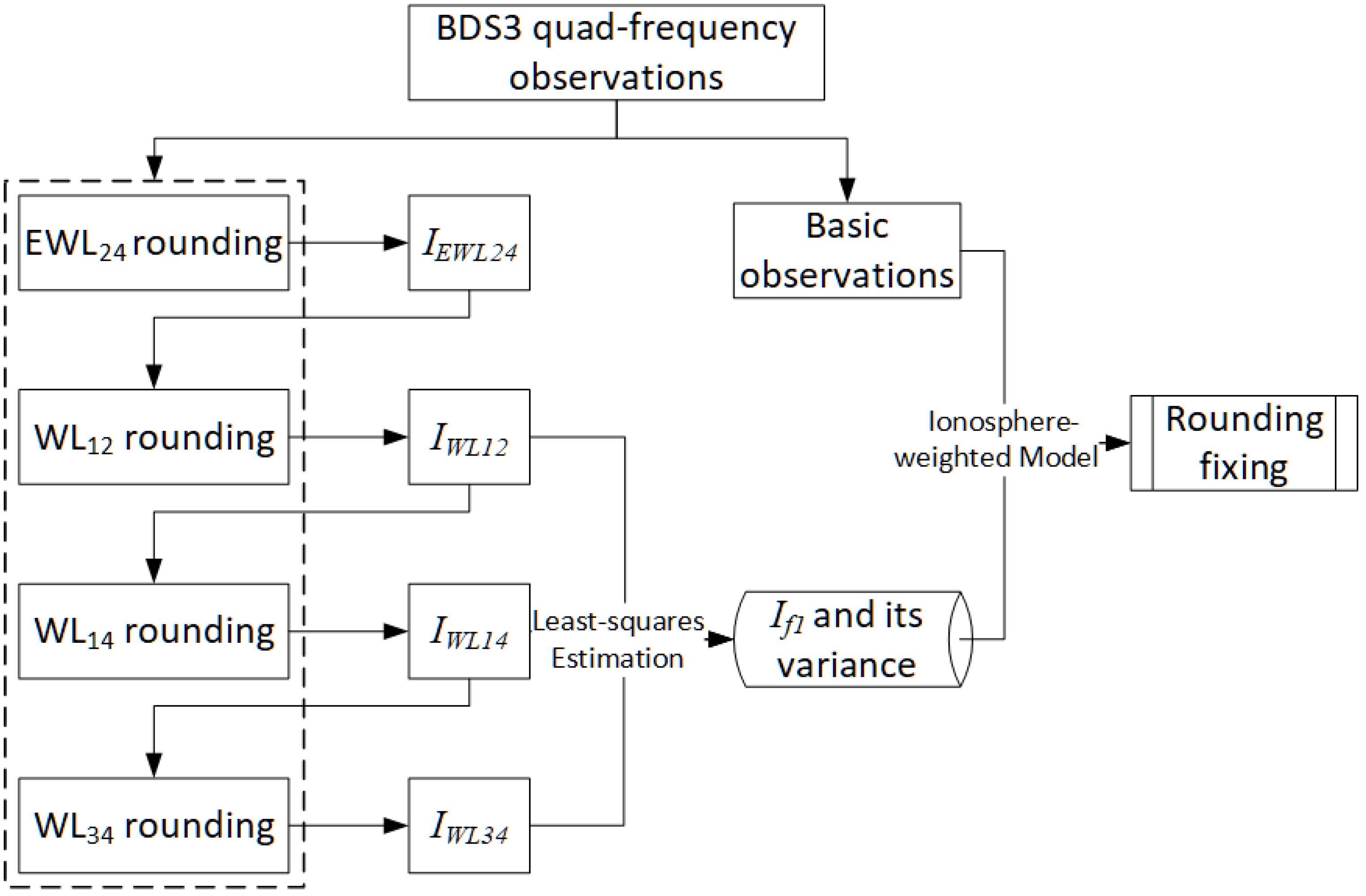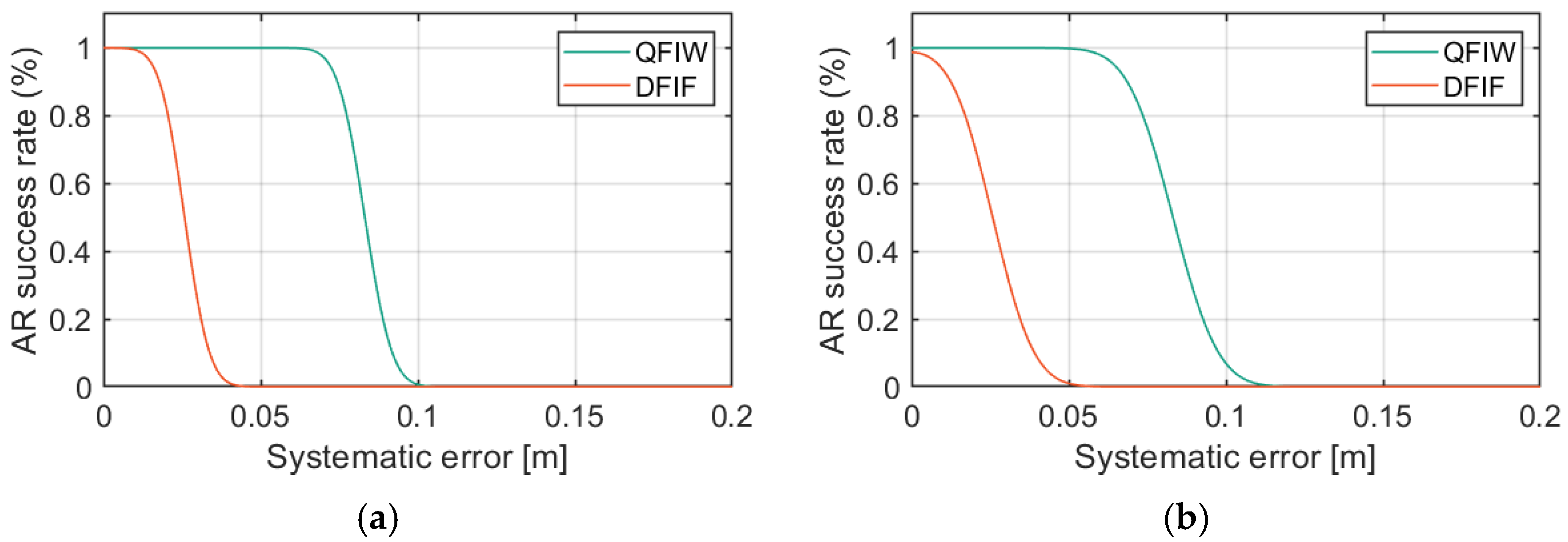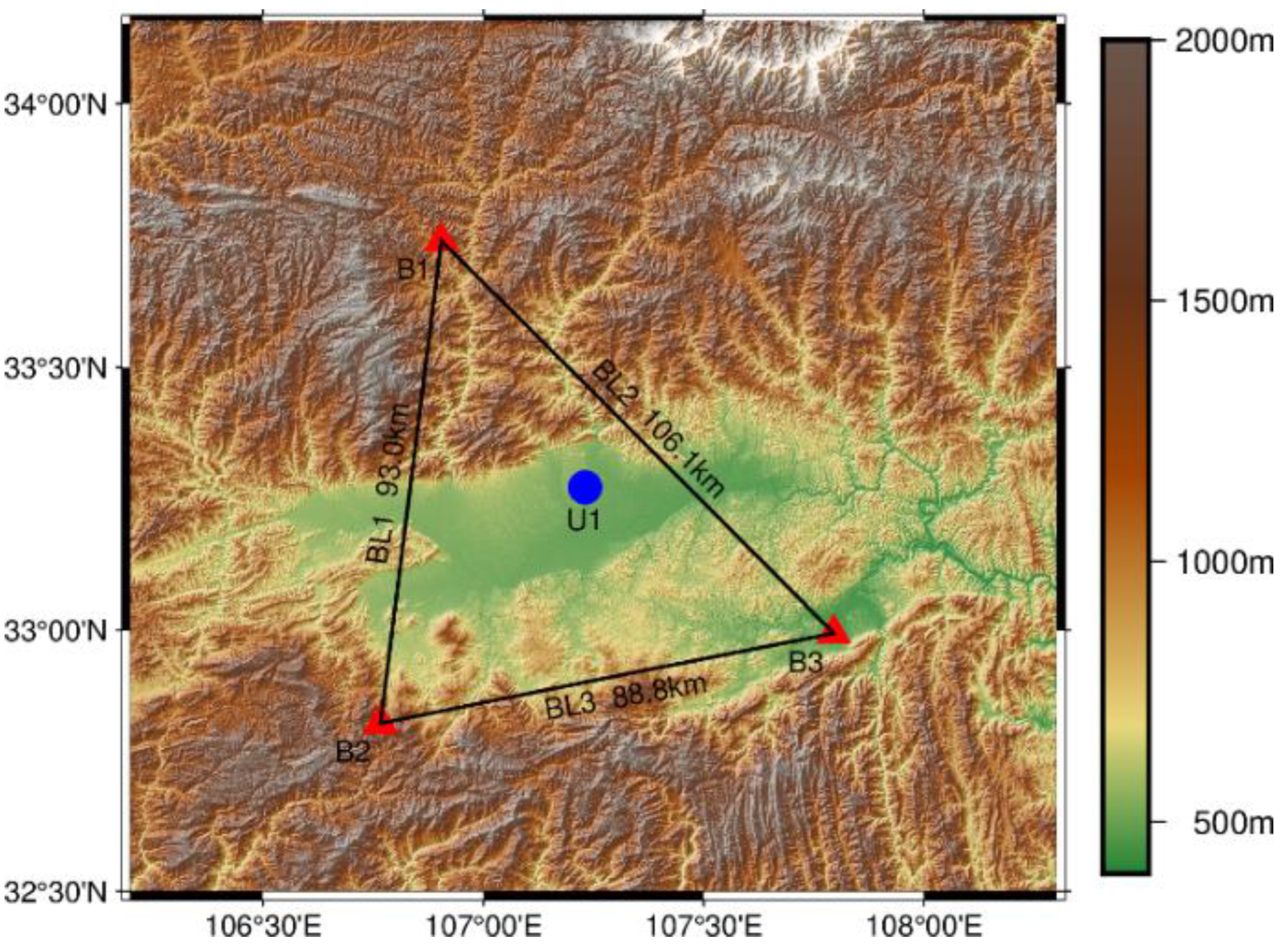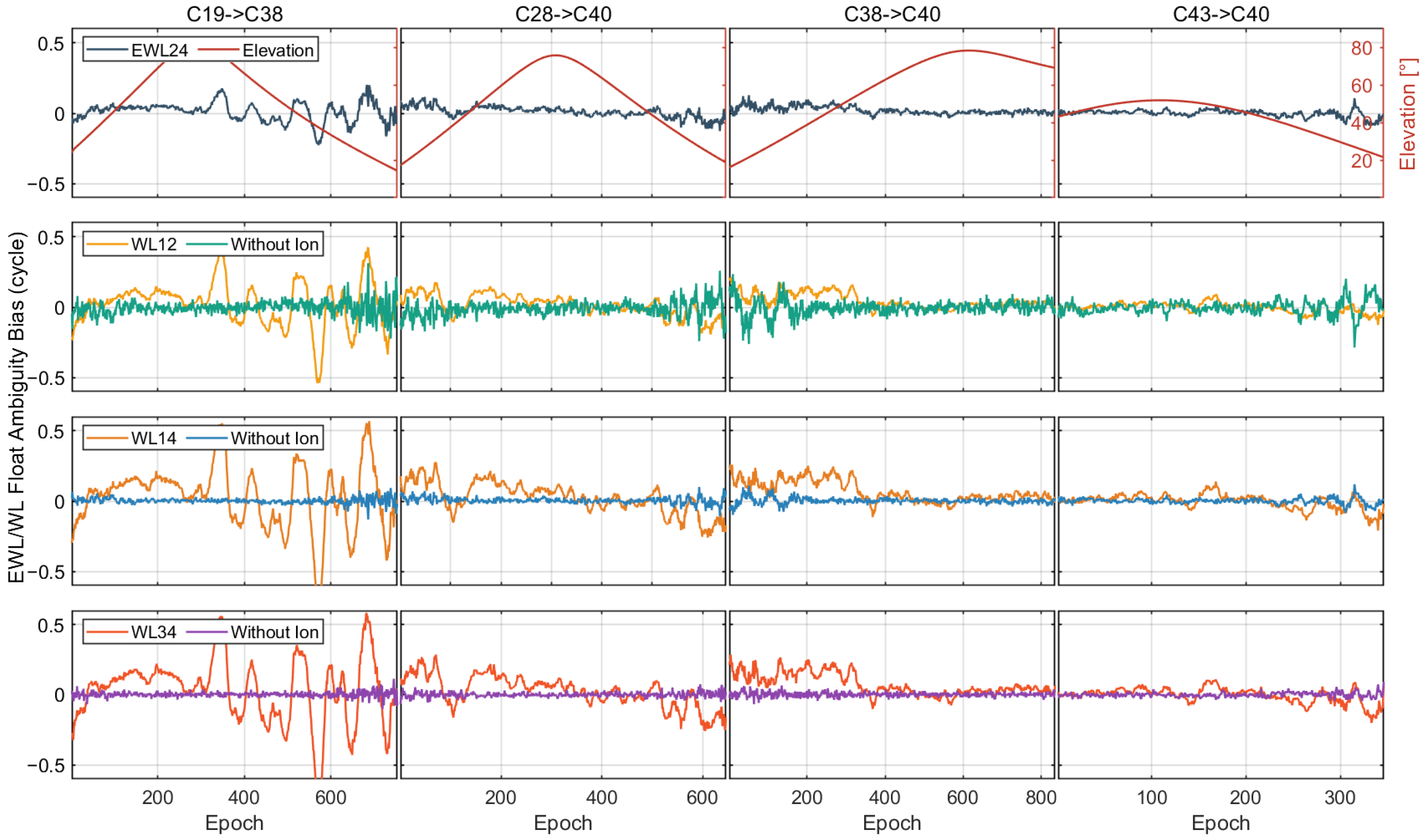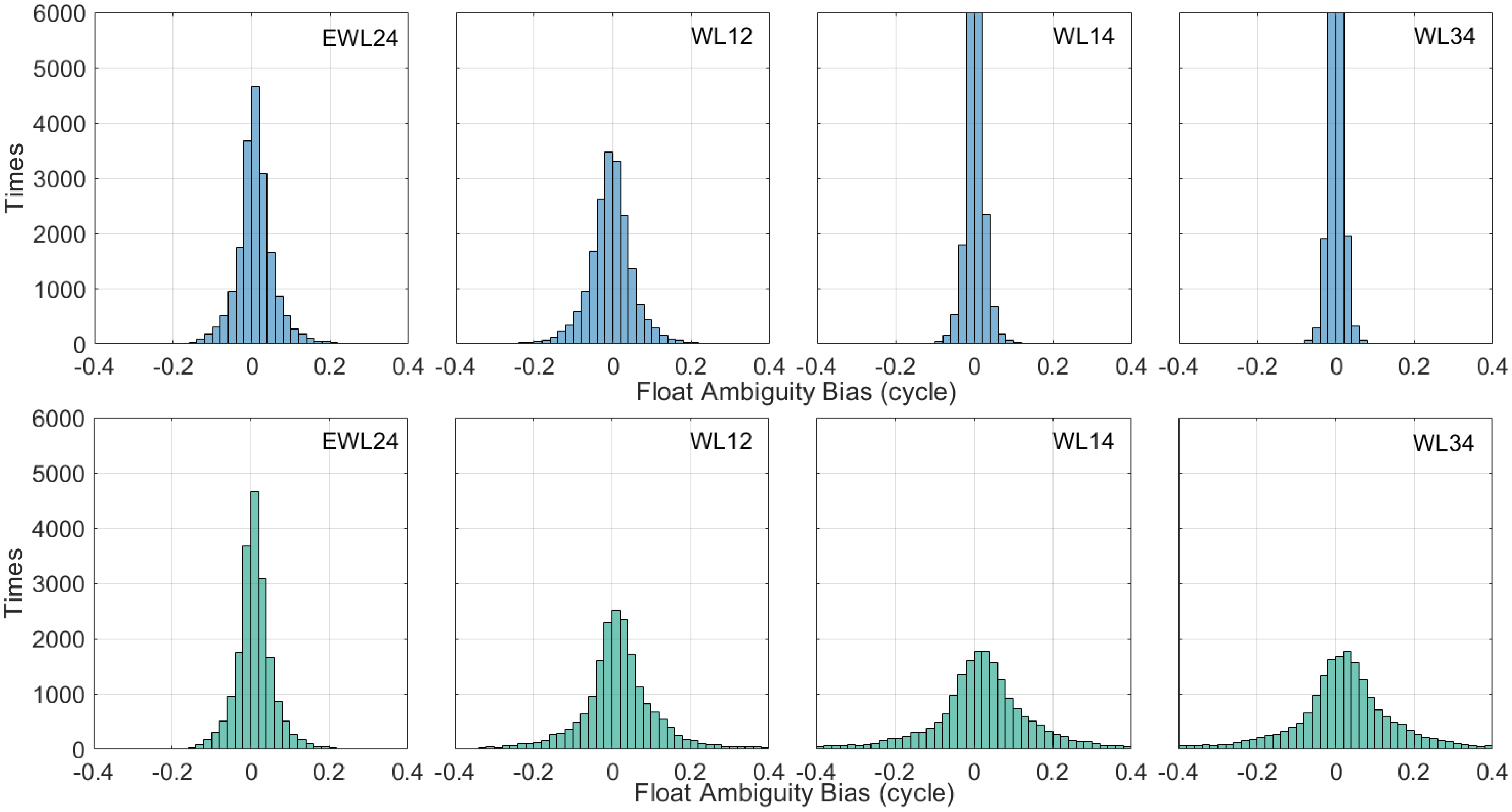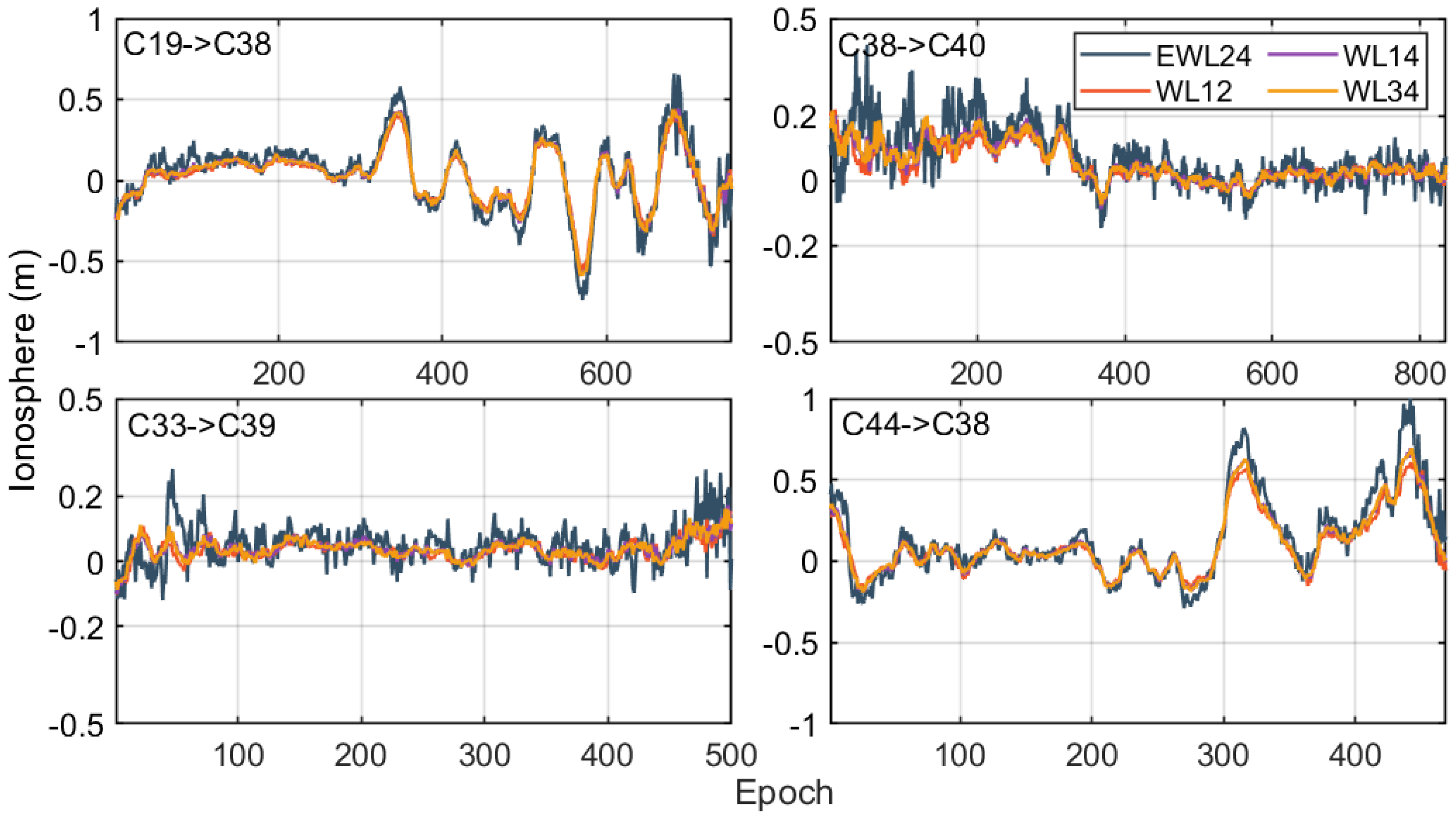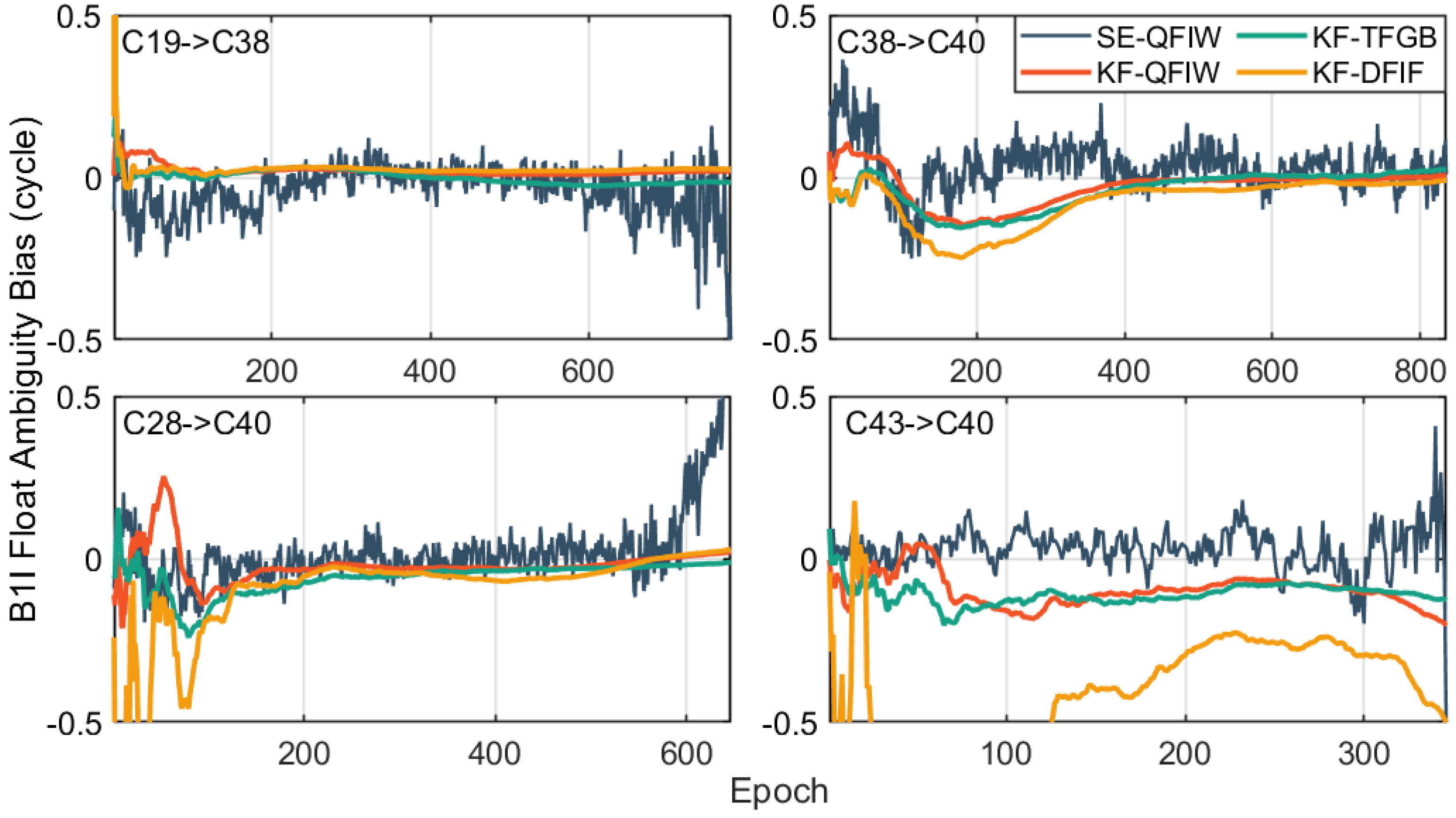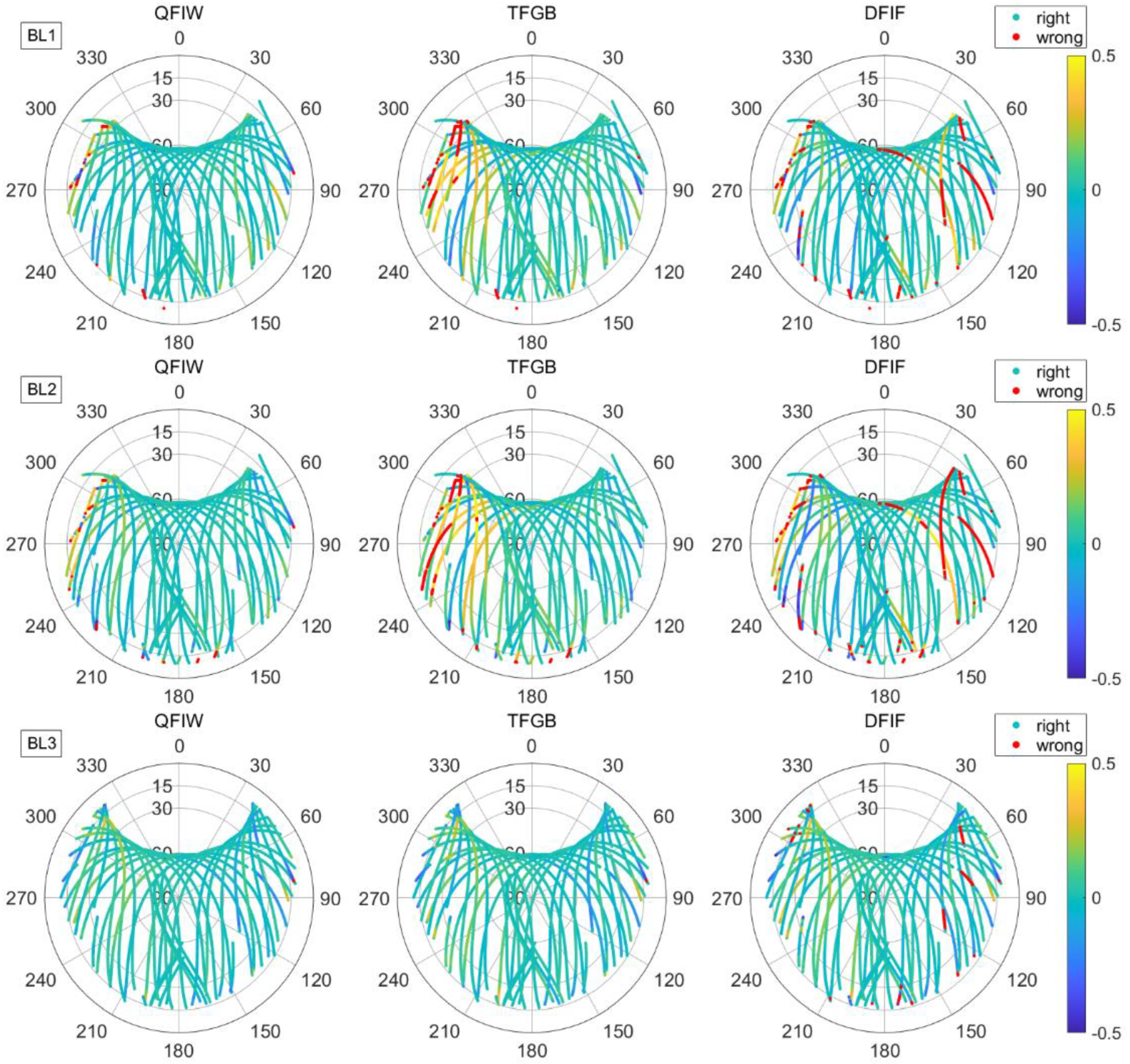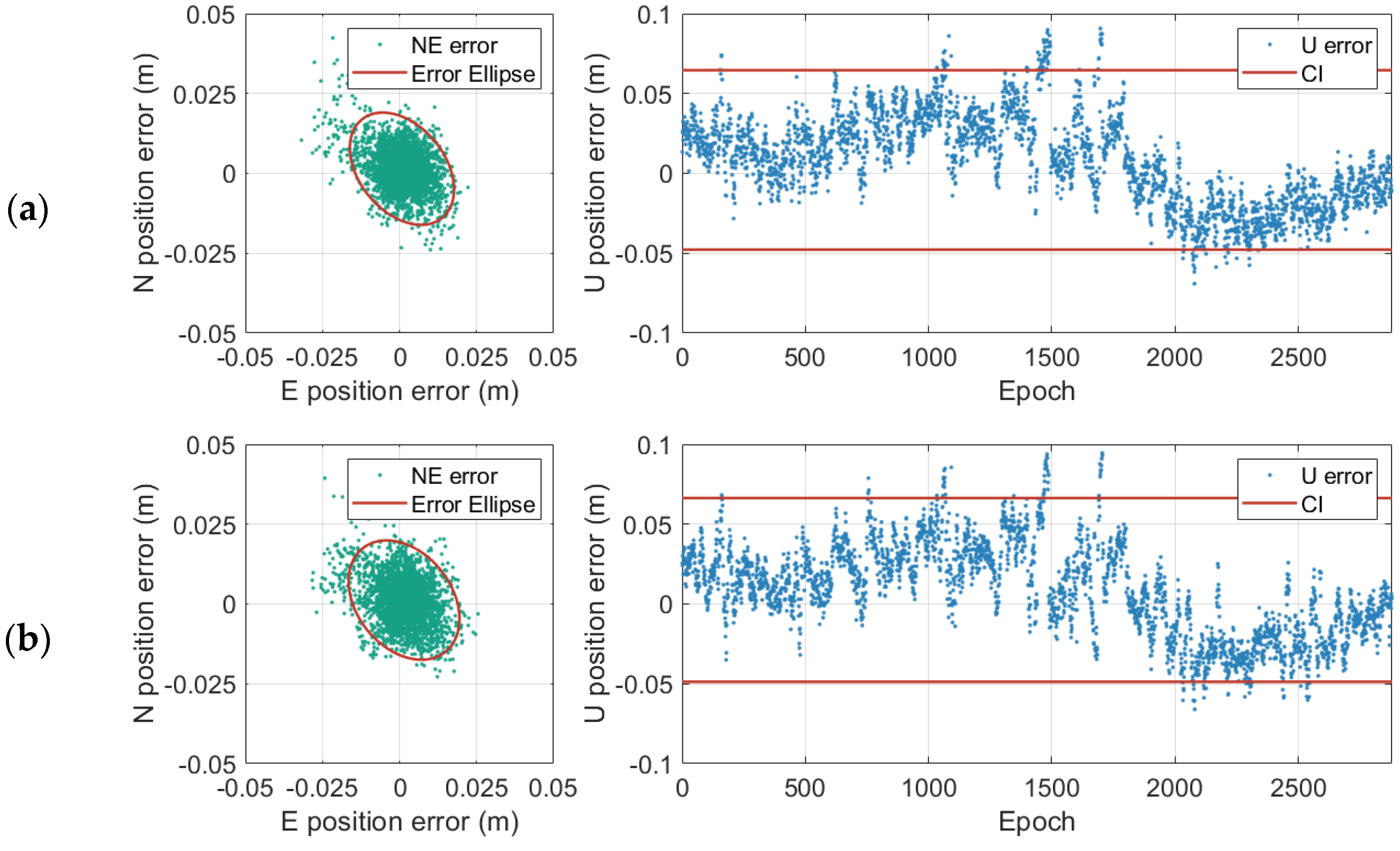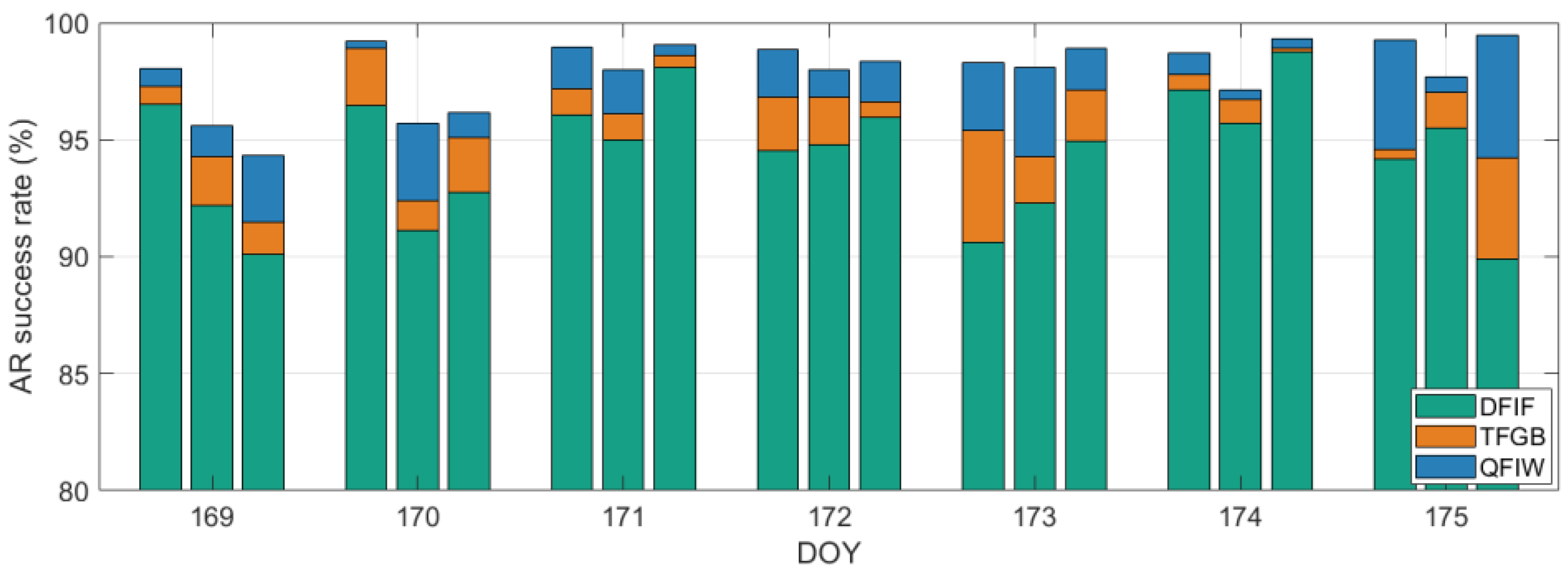1. Introduction
The BeiDou Global Navigation Satellite System (BDS-3) broadcasts five frequency signals, namely B1I, B3I, B1C, B2a, and B2b, centered on 1561.098, 1268.520, 1575.420, 1176.450, and 1207.140 MHz, respectively [
1]. Among these signals, B1I, B3I, B1C, and B2a can be received by more civil receivers. This study examines the benefits of these quad-frequency signals with regard to AR for long baseline in a network.
Table 1 shows the commonly used signals of BDS-2 and BDS-3 [
1,
2].
Multi-frequency observations have significant effects on accelerating ambiguity resolution (AR) and eliminating observation errors such as the ionosphere, and can effectively improve the availability and reliability of RTK positioning. Common multi-frequency AR models include three carrier ambiguity resolution (TCAR) [
3,
4] and cascading integer resolution (CIR) [
5,
6]. The basic principles of these two methods are similar. The main idea of TCAR is to fix the ambiguity according to the degree of difficulty. On the basis of selecting the optimal combined observation value of three frequencies, first it fixes the wavelengths of the long extra-wide-lane (EWL) and wide-lane (WL) ambiguities, and finally it fixes the narrow-lane (NL) ambiguity. Common TCAR models include geometry-based (GB), geometry-free (GF), and geometry-ionosphere-free (GIF) models [
7,
8,
9,
10].
Early TCAR methods basically used the GF model to solve ambiguity [
11,
12,
13]. Although the GF model will be affected by atmospheric errors, pseudo-range noise, and multipath delays, it is still widely used due to its long wavelength and concise mathematical calculations. The GB model estimates atmospheric error as unknown parameters together with baseline and ambiguity parameters, which greatly improves the strength of the model compared with the GF model. Feng and Li et al. comprehensively analyzed the impact of orbit, ionospheric, and tropospheric errors on the accuracy of combined observations (combined noise). The results showed that even for long baselines, the impact of combined noise on the ambiguity of optimized EWL/WL combinations was basically within 0.2 cycles. However, it is difficult for the GB model to fix the ambiguity of NL [
7,
11,
13]. Gao Wang et al. proposed a network RTK single epoch positioning method based on the BDS three-frequency WL combination. Real-time dynamic positioning is carried out by using the WL observation with fixed ambiguity and minimum noise, and the atmospheric delay correction is obtained by interpolation. The experimental results showed that the success rate of a single epoch model was higher than 99.9%, and the positioning mean error was 3–4 and 5 cm, respectively, for the horizontal and vertical direction [
14].
In order to further fix the ambiguity of NL, Li et al. proposed a GIF model using two EWL/WL observations with fixed ambiguity and one NL observation, and estimated the NL ambiguity [
13]. However, due to the large model combination coefficient, it was not easy to fix the ambiguity of the narrow lane. Wang et al. added pseudo-range observation to the GIF model and derived a three-frequency combination coefficient of GPS, Galileo, and BDS systems with minimum noise. However, due to the influence of system noise, such as multipath delays, the floating-point solution deviation of basic phase ambiguity was greater than the theoretical derivation result, and hundreds of epochs were needed for smoothing to be less than 0.5 cycles [
15]. In addition, Li et al. constructed a GB model using code observations, two EWL observations with fixed ambiguity, and L1 phase observations, and further strengthened the model by imposing constraints on ionospheric and tropospheric parameters. The above models have been verified in ambiguity resolution and high-precision positioning for BDS-2, BDS-3, Galileo, and multi-system GNSS, and have achieved outstanding results [
16,
17,
18].
With the modernization of Galileo and the completion of BDS-3 construction, many scholars have carried out research on fast resolution of quad-frequency or even five-frequency ambiguity. Compared with three-frequency observations, the new frequency point can increase the number of redundant observations and the strength of the positioning model, and theoretically improve the positioning accuracy and robustness [
6,
19]. Wang et al. used five-frequency Galileo observations, adopted a mathematical model to estimate ionospheric delay with non-combined phase/code observations, and realized the AR of a baseline hundreds of kilometers long under the condition of mitigating the multipath influence. The fixing success rate of three-frequency, quad-frequency, and five-frequency observations was 95, 98, and 99%, respectively, within 10 s smoothing. Therefore, it is proved that quad-frequency or even five-frequency observations provide a certain degree of improvement in the effect of estimating ionospheric delay and AR [
19].
Li et al. discussed the advantages of quad-frequency observations, and gave several groups of EWL/WL combination coefficients. Using the observation of ionosphere-free (IF) EWL, dynamic positioning with an accuracy of 0.5 m under a baseline length of 27 km and horizontal positioning accuracy of 1 m under a baseline length of 300 km were achieved. In addition, if the NL observations are used to smooth the IF/EWL combination observations in a short period of time, the positioning error will be reduced to the centimeter level [
20]. Most of the research on basic AR using BDS-3 quad-frequency observations are concentrated in the field of PPP [
21,
22,
23].
Ionosphere processing models mainly include ionosphere-fixed, ionosphere-float, ionosphere-free, and ionosphere-weighted models [
24]. For sufficiently short baselines, the ionosphere becomes fully correlated. As a result, we can assume that the DD ionospheric delays are known or are absent from the model, which we call the ionosphere-fixed model. However, this assumption is no longer valid when the baseline length increases. For sufficiently long baselines, we can eliminate the influence of ionospheric delays by using the frequency dependent characteristics of the ionosphere through combined dual-frequency or multi-frequency observations, which we call the ionosphere-free model. However, due to the large observation noise, it is generally combined with WL observations to calculate NL ambiguities for positioning. Moreover, we can parameterize the ionosphere in the positioning model to produce an ionosphere-float model that is equivalent to the ionosphere-free model. Therefore, we should try to improve the accuracy of ionosphere information as much as possible to enhance the model strength. For instance, the ionosphere-weighted model is often applied instead of the ionosphere-float model [
25].
However, few researchers have comprehensively investigated the benefits of quad-frequency basic AR when the reference stations’ coordinates are precisely known. Hence, in this study, we investigated the aforementioned benefits of quad-frequency signals of BDS-3 in WL AR ionospheric estimation and basic AR in network-based computation.
In the following sections, we introduce the general formula of combined multi-frequency observations and give some common combinations of BDS-3 quad-frequency with longer wavelength, less combined noise, or less total noise in cycles. Then, the appropriate EWL/WL combination is selected according to the total noise in cycles and the combined noise coefficient, and the ambiguities of all WL combinations are fixed according to the cascading AR model. In addition, the ionospheric delays are calculated according to three groups of WL observations with fixed ambiguity, and the optimal solution is estimated by least squares. Then, using the ionosphere-weighted model, the floating-point solution of the basic phase ambiguity is estimated by the Kalman filter (KF) and the basic ambiguity is fixed by rounding or the LAMBDA algorithm. Finally, two experiments are conducted to evaluate the performance of quad-frequency basic AR in network-based computation compared with the double-frequency ionosphere-free (DFIF) and triple-frequency geometry-based (TFGB) models [
9].
3. Results
Two CORS (Continuously Operating Reference Stations), each consisting of three reference stations and one user station, distributed around 33°N, 107°E and 32°N, 119°E, respectively, were used for processing. BDS-3 observations of all eight stations were processed on four frequencies. The two CORS are distributed in central China, for long baselines in other regions; the biggest difference is the number of BDS satellites. In this paper we mainly studied the advantages of quad-frequency observations in ambiguity resolution and positioning accuracy compared with double-frequency observations, so the number of satellites does not have a substantial impact on the conclusions.
For the first CORS network, the base stations and user station had the same types of receivers and antennas—Trimble Alloy receivers and TRM159900.00 SCIS antennas. The average length of three baselines is close to 100 km, and the maximum height difference between base stations is up to 1000 m. Observations of day of year (DOY) 148 in 2020 were used for experimental verification in this study. The elevation mask was set to 10°, and the sample rate was 30 s.
Figure 3 displays the geographical location of the stations. The broadcast ephemerides were used to assess the satellite ORTs in real time. The tropospheric delay was mitigated by an empirical model, saastamoinen + GPT2_1w. The receiver antenna phase offset was ignored, as the same antenna type was used. The quad-frequency DD algorithm was used in the data processing, and the ambiguities of each epoch were resolved by Kalman filter. With all ambiguities resolved, accurate tropospheric and ionospheric delays of each baseline could be calculated, which were then used to interpolate the atmospheric delay at the user’s position and finally generate virtual observations.
Three groups of BDS-3 network RTK solutions were compared: DFIF, TFGB, and QFIW. We compared the fixing success rate of WL and basic ambiguities, the number of successfully fixed satellites, and the user-side positioning accuracy of the two methods, as follows.
The accuracy of the float WL ambiguity directly determines the success rate of the WL ambiguity resolution, and it has a great impact on both the double-frequency and quad-frequency solution. We followed the idea of cascading AR. First, the EWL
24 ambiguities were fixed, and the ionospheric delay
was calculated according to Equation (5). It can be seen from
Table 2 that the fixing success rate of rounding was almost 100%. Then, the ionospheric delay
was used as a constraint equation to improve the accuracy of WL
12 floating ambiguities. Finally, the fixed WL
12 ambiguities were used to calculate the higher-precision ionospheric delay
, which in turn fixed the WL
14 and WL
34 ambiguities according to the above method.
We selected four sets of satellite pairs (C19-C38, C28-C40, C38-C40, and C43-C40) to compare the accuracy of the WL float ambiguities before and after ionospheric correction. It can be seen from Equation (2) that the floating solution bias mainly included ionospheric delay, tropospheric model errors (mainly wet delay), and multipath delay, among which ionospheric delay has the greatest influence. Therefore, the WL floating ambiguities after ionospheric correction were basically close to integers.
Figure 4 shows the float ambiguity biases of EWL and WL combinations. As shown in the figure, all EWL ambiguities could be fixed correctly, benefiting from the long wavelength. In addition, the WL float ambiguity bias of some satellites exceeds 0.5 cycles, indicating that direct rounding will cause this part of the ambiguity to be fixed incorrectly. This will also cause errors in the basic ambiguity resolution. In contrast, the bias of the WL float solution after ionospheric correction was basically within 0.2 cycles, which can effectively ensure the success rate of WL ambiguity resolution by rounding. The WL float solution bias after ionospheric correction was close to white noise, and the fluctuation at a low altitude angle was mainly caused by residual tropospheric wet delays and multipath delays. It can also be seen from
Figure 4 that the noise of combinations WL
14 and WL
34 were equivalent and smaller than that of WL
12.
The floating solution biases of WL ambiguities were counted, and are displayed as histograms in
Figure 5. The upper panel shows the result after ionospheric correction, and the lower panel shows the result without ionospheric correction. It can be seen from the figure that the WL floating solution bias after ionospheric correction was more concentrated around 0 cycle, and most deviations are less than 0.1 cycles, especially for combinations WL
14 and WL
34.
The WL floating solution bias was calculated at intervals of 0.1 cycles, as shown in
Table 3. Without correcting the ionosphere, the probability of deviation less than 0.5 cycles was 99.7/98.6/98.5% for combinations WL
12/WL
14/WL
34, respectively, which is also regarded as the WL ambiguity fixed success rate by rounding. The fixing success rate after ionospheric correction could reach 100%. In practical applications, the threshold for rounding the WL ambiguity to a fixed value is 0.3–0.4 cycles. The fixing threshold will directly reduce the number of satellites participating in the fixing by 3–6%, which will affect the positioning accuracy of users.
In order to further improve the accuracy of the estimated ionospheric delay, three sets of uncorrelated WL observations (WL
12/WL
14/WL
34) were selected for calculation, and the optimal value was estimated by LSE.
Figure 6 shows the ionospheric delay calculated by various EWL and WL observations. It can be seen that
had the largest noise, and
and
had the smallest noise, which is consistent with the theoretical value of the noise amplification factor given in
Table 2. Ultimately, the amplification factor of the noise of the ionospheric delay estimated by LSE was about 4.5, corresponding to the basic ambiguity deviation of about 0.1 cycles.
Figure 7 shows the deviations of basic float ambiguities calculated by the three models, DFIF, TFGB, and QFIW. The black, red, green, and orange lines indicate the float ambiguity bias calculated by the single epoch (SE) QFIW model, the KF-QFIW model, the KF-TFGB model, and the KF-DFIF model, respectively. It can be seen from the figure that the estimated bias calculated by the SE-QFIW model was mostly less than 0.5 cycles, which could be fixed correctly by rounding. Only at low elevation, some satellites’ ambiguity bias exceeded 0.5 cycles. The accuracy of the KF-QFIW model was further improved, especially for low-altitude satellites, and an almost 100% rounding fixing success rate could be achieved. The ambiguity bias of the TFGB model is pretty close to the QFIW model. For the DFIF model, due to the large, combined noise, the result was worse than the KF-QFIW model in both ambiguity accuracy and convergence speed.
In order to compare the accuracy of the three processing models intuitively, we drew sky maps of the float ambiguity bias, as shown in
Figure 8. From top to bottom in the figure are baselines BL1, BL2, and BL3. Red dots indicate deviation of more than 0.5 cycles, and other colors indicate deviation of less than 0.5 cycles. The corresponding relationship between bias and color is shown in the color bar on the right side of the figure. It can be seen from the figure that the floating ambiguity bias of the QFIW model was more than 0.5 cycles at individual low-altitude satellites only sporadically. However, there was a significantly larger proportion of float ambiguity bias of more than 0.5 cycles in the DFIF model, and some satellites exceeded the limit for a long time. The result of the TFGB model is between the two.
It can be seen from the statistical results in
Table 4 that utilizing the QFIW model proposed in this study and the rounding fixing strategy, the ambiguity resolution success rate of the three baselines was 99.66, 99.56, and 99.96%; compared with 96.96, 95.61, and 98.74% for the traditional DFIF model and 98.32, 97.81, and 99.98% for the TFGB model, there was a significant improvement. When the LAMBDA (least-square ambiguity decorrelation adjustment) search strategy was used, the QFIW model was still slightly improved compared to the traditional DFIF and TFGB models.
In addition, we made a comparative analysis of the two models on a time scale, and drew a time-sequence diagram of the number of satellites successfully fixed by the two models. It can be seen from
Figure 9 that the QFIW model successfully fixed more satellites than the DFIF and TFGB models. In the initialization phase, the advantages of the QFIW model were more obvious. Within 300 s after initialization, the number of satellites it successfully fixed was 7.7, 13.3, and 2.1% higher for the three baselines compared to the DFIF model.
Interpolating ionospheric and tropospheric delays at the user’s position is the key to realizing the user’s high-precision positioning. Based on basic ambiguity fixing, the ionospheric and tropospheric delays at each baseline could be calculated, and the atmospheric error at the user’s position could be interpolated by LIM/LSM/DIM or other models. In this study, the LSM model was selected for atmospheric interpolation [
26], and the user positioning results are shown in
Figure 10. The green and blue dots in the figure comprise a scatter diagram of positioning error, and the red line represents the error ellipse or 95% confidence interval (CI). The root mean square (RMS) values of the positioning results were 0.0069/0.0072/0.0281 m for E/N/U directions, respectively, for the QFIW model, 0.0073/0.0076/0.0288 m for the TFGB model, and 0.0085/0.0103/0.0342 m for the DFIF model. It can be concluded that using the QFIW model to fix the ambiguity between reference stations could significantly improve the user’s positioning accuracy.
For the second CORS network, the base stations and user station also had the same types of receiver and antenna—the CHCNAV P5 receiver (with UNICORE UB4B0 board) and the CHCNAV AT611 antenna. The average length of the three baselines was about 50 km. Observations of DOY 169–175, 2021, were used for experimental verification in this study. The elevation mask was set to 10°, and the sample rate was 10 s.
Figure 11 displays the geographical location of the stations. The data processing strategy was consistent with the first CORS.
Figure 12 shows the ambiguity fixing success rate of three baselines for seven consecutive days under the two models. The three bars, from left to right, for each day represent baseline JN-JR, JN-LI, and JR-LI, respectively. It can be seen from the figure that the QFIW model had a better success rate than the TFGB and DFIF models for all baselines on all days. The success rate increased from 94.4 and 96.1% to 98.0% compared with the DFIF and TFGB models.
Figure 13 illustrates the user positioning errors under the three models. The three bars, from left to right, for each day represent E, N, and U directions. It can be seen from the figure that the positioning errors were better for the QFIW model than the DFIF and TFGB models on all seven days. For the QFIW model, the plane positioning error was always better than 2 cm, while the maximum vertical error exceeded 6 cm, which may have been caused by large atmospheric modeling error and multipath delay.
We calculated the statistics of the positioning results of the three models, and the results are shown in
Table 5. As summarized in
Table 5, the average positioning error was 0.0121/0.0107/0.0508 m for E/N/U directions, respectively, for the QFIW model, and 0.0152/0.0156/0.0585 m for the DFIF model, with the positioning accuracy in the three directions improved by 20.6/31.5/13.1%; the average positioning error was 0.0129/0.0139 and 0.0539 m for the TFGB model, with the positioning accuracy improved by 6.3/22.9/5.8%.
5. Conclusions
Based on BDS-3 quad-frequency observation data, addressing the large noise of the traditional dual-frequency ionosphere-free model (DFIF), a quad-frequency ionosphere-weighted (QFIW) model was proposed to realize fast and accurate fixing of the basic ambiguity between reference stations. For the traditional DFIF and TFGB models, it has been demonstrated that the wide-lane (WL) ambiguity will be fixed at wrong integers after smoothing due to the influence of residual tropospheric and multipath delays. Moreover, due to the large noise of ionosphere-free (IF) combinations, the estimated floating-point ambiguities are inaccurate. The QFIW model proposed in this study could effectively improve the rounding success rate of WL and basic ambiguities.
First, based on the combined observation theory, considering the wavelength and noise amplification factor of the combinations, an EWL observation (0, 1, 0, −1) and three independent WL observations (1, −1, 0, 0), (1, 0, 0, −1), and (0, 0, 1, −1) were selected. Then, on the basis of fixing the ambiguities of the EWL by smoothing and rounding, the ambiguities of the three WL combinations were fixed one-by-one with ionospheric delay correction; the double-differenced ionospheric delays , , and were calculated by the fixed-ambiguity WL observations. Finally, the ionospheric correction values of the basic frequency point were estimated by LSE with three independent ionospheric delays. In addition, taking the estimated ionospheric correction values as a priori information, the ionosphere-weighted model was constructed with uncombined code and phase observations. The basic ambiguities were fixed by KF and rounding. Finally, based on the fixed basic ambiguities between reference stations, virtual observation values were generated, and user positioning accuracy was evaluated.
In this study, real data of two CORS (DOY 148 in 2020 and 169–195 in 2021) were used to verify the proposed algorithm. The rounding success rate of the WL ambiguity was significantly improved with ionospheric correction. Even when the rounding threshold was set to 0.3 cycles, an almost 100% success rate could be achieved. Then, we analyzed the advantages of the QFIW model from the two scales of space and time and found that the model significantly improved the accuracy of the basic ambiguity estimations for high-altitude-angle satellites and at the initial stage of initialization, and had good performance for low-altitude-angle satellites. According to the statistical results, the QFIW had a better success rate than the DFIF and TFGB models for all baselines on all days, and the success rate increased from 94.4 and 96.1% to 98.0%. Furthermore, the user positioning accuracy was improved by 20.6, 31.5, and 13.1% for E, N, and U directions compared with the DFIF model, and by 6.3, 22.9, and 5.8% compared with the TFGB model.
